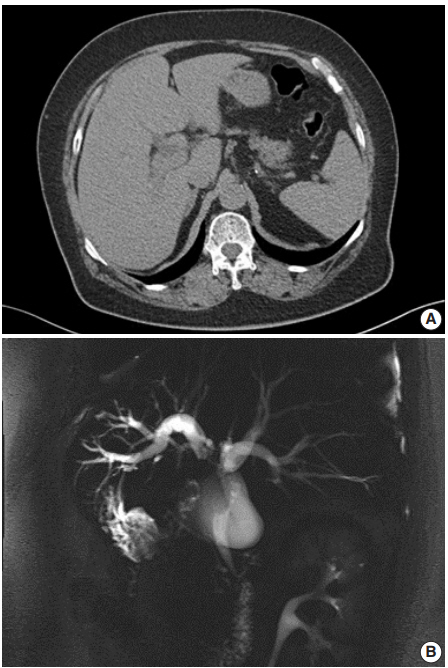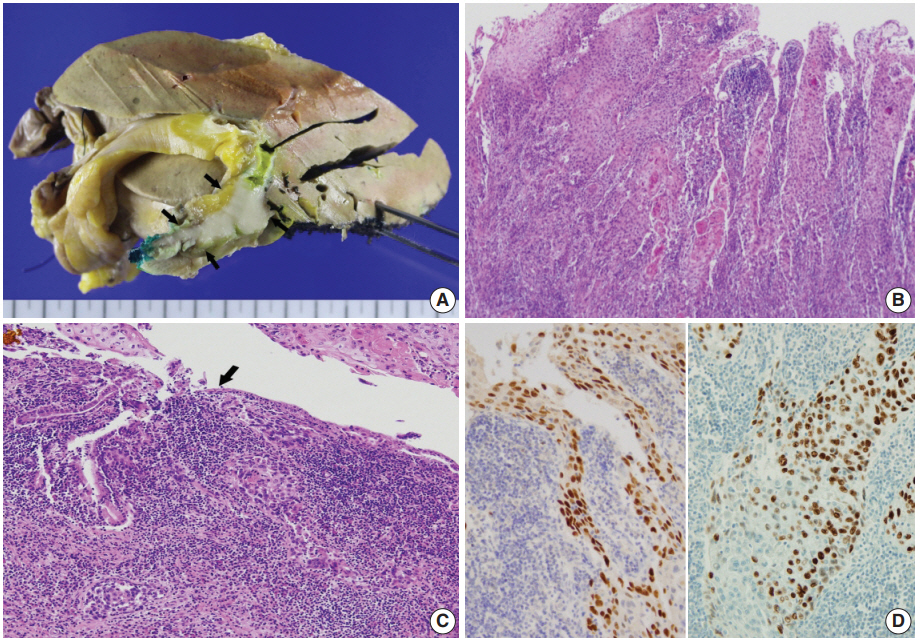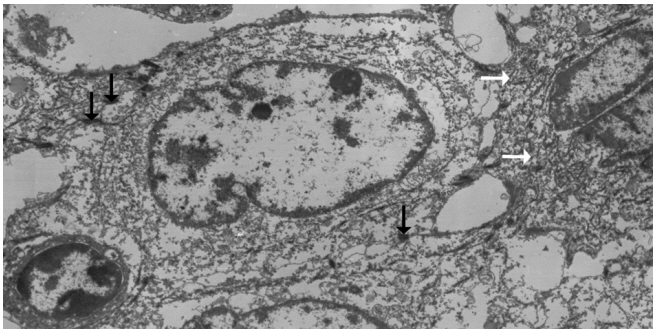Articles
- Page Path
- HOME > J Pathol Transl Med > Volume 53(2); 2019 > Article
-
Case Study
Squamous Cell Carcinoma of the Extrahepatic Common Hepatic Duct -
Myunghee Kang1
 , Na Rae Kim1
, Na Rae Kim1 , Dong Hae Chung1
, Dong Hae Chung1 , Hyun Yee Cho1
, Hyun Yee Cho1 , Yeon Ho Park2
, Yeon Ho Park2
-
Journal of Pathology and Translational Medicine 2019;53(2):112-118.
DOI: https://doi.org/10.4132/jptm.2018.09.03
Published online: October 1, 2018
1Department of Pathology, Gil Medical Center, Gachon University College of Medicine, Incheon, Korea
2Department of Surgery, Gil Medical Center, Gachon University College of Medicine, Incheon, Korea
- Corresponding Author Na Rae Kim, MD, PD Department of Pathology, Gil Medical Center, Gachon University College of Medicine, 21 Namdong-daero 774beon-gil, Namdong-gu, Incheon 21565, Korea Tel: +82-32-460-3073 Fax: +82-32-460-2394 E-mail: clara_nrk@gilhospital.com
© 2019 The Korean Society of Pathologists/The Korean Society for Cytopathology
This is an Open Access article distributed under the terms of the Creative Commons Attribution Non-Commercial License (http://creativecommons.org/licenses/by-nc/4.0) which permits unrestricted non-commercial use, distribution, and reproduction in any medium, provided the original work is properly cited.
Figure & Data
References
Citations

- Deciphering cholangiocarcinoma heterogeneity and specific progenitor cell niche of extrahepatic cholangiocarcinoma at single-cell resolution
Chunliang Liu, Xiang Wang, Erdong Liu, Yali Zong, Wenlong Yu, Youhai Jiang, Jianan Chen, Mingye Gu, Zhengyuan Meng, Jingfeng Li, Yang Liu, Yongjie Zhang, Jing Tang, Hongyang Wang, Jing Fu
Journal of Hematology & Oncology.2025;[Epub] CrossRef - Extrahepatic cholangiocarcinoma: Current concepts in histopathology, immunohistochemistry, and molecular diagnostics
Jared Beyersdorf, M. Lisa Zhang
Seminars in Diagnostic Pathology.2025; 42(6): 150949. CrossRef - Cholangiocarcinoma With Liver Metastasis in Squamous Cell Carcinoma Type: A Case Report
Jane Chiang
Journal of Diagnostic Medical Sonography.2024; 40(6): 609. CrossRef - A Rare Case of Squamous Cell Carcinoma of the Bile Duct
Julianna Tantum, Rachael Schneider, Stefanie Gallagher, Kyley Leroy, Jared Lander, Patricia Wong
ACG Case Reports Journal.2023; 10(8): e01119. CrossRef - Metastatic Anal Squamous Cell Carcinoma Presenting as an Indeterminate Biliary Stricture Diagnosed By Cholangioscopy
Ritu Nahar, Ian Holmes, Jeffrey Baliff, Austin Chiang, Thomas Kowalski
ACG Case Reports Journal.2022; 9(6): e00785. CrossRef - Temporal Changes in Cholangiocarcinoma Incidence and Mortality in the United States from 2001 to 2017
Milind Javle, Sunyoung Lee, Nilofer S Azad, Mitesh J Borad, Robin Kate Kelley, Smitha Sivaraman, Anna Teschemaker, Ishveen Chopra, Nora Janjan, Shreekant Parasuraman, Tanios S Bekaii-Saab
The Oncologist.2022; 27(10): 874. CrossRef - PRIMARY SQUAMOUS CELL CARCINOMA OF THE COMMON BILE DUCT WITH LIVER METASTASES
Dhouha BACHA, Mohamed HAJRI, Wael FERJAOUI, Ghofrane TALBI, Lasaad GHARBI, Mohamed Taher KHALFALLAH, Sana ben SLAMA, Ahlem LAHMAR
ABCD. Arquivos Brasileiros de Cirurgia Digestiva (São Paulo).2021;[Epub] CrossRef - S1510 A Rare Case of Squamous Cell Carcinoma of the Bile Duct
Stefanie Gallagher, Kyley Leroy, Julianna Tantum, Babak Etemad
American Journal of Gastroenterology.2021; 116(1): S688. CrossRef - Heparin
Reactions Weekly.2019; 1752(1): 184. CrossRef - Carcinoma primario de células escamosas del conducto hepático común: a propósito de un caso
Ana Delgado Maroto, Andrés Barrientos Delgado, Marta Lázaro Sáez, Samia Hallouch Toutouh, Enrique Práxedes González
Gastroenterología y Hepatología.2019; 42(7): 436. CrossRef - Primary squamous cell carcinoma of the extrahepatic bile duct: A case report
Ana Delgado Maroto, Andrés Barrientos Delgado, Marta Lázaro Sáez, Samia Hallouch Toutouh, Enrique Práxedes González
Gastroenterología y Hepatología (English Edition).2019; 42(7): 436. CrossRef
 PubReader
PubReader ePub Link
ePub Link-
 Cite this Article
Cite this Article
- Cite this Article
-
- Close
- Download Citation
- Close
- Figure



Fig. 1.
Fig. 2.
Fig. 3.
| No. | Age (yr)/Sex | Site | Clinical summary including tumor markers | Remarkable pathologic findings | Distant metastasis | TNM/AJCC at the diagnosis | Treatment | Outcome (follow-up) |
|---|---|---|---|---|---|---|---|---|
| 1 | 58/M | Proximal CBD (upper 1/4) | Jaundice, knife-like abdominal pain | No | Liver, retroperitoneal lymph node | Stage IVB |
No surgery | Died (23 days) |
| 2 | 24/F | Junction of proximal CBD and cystic duct | Jaundice, RUQ pain, elevated CEA | SCC, MD without lymphovascular, perineural invasion | Liver | T2aN0M1 Stage IVB |
Pancreaticoduodenectomy, CTx (cyclophosphamide, MTX, doxorubicin, procarbazine) | Died (8 mo) |
| 3 | 68/M | Mid CBD | Secondary biliary cirrhosis, portal hypertension, hepatic failure | SCC, WD | No | TxNOMO in autopsy Stage I | Cholecystectomy with T tube and wedge biopsy of liver | Died (6 mo) |
| 4 | 56/M | Hilar | Jaundice | SCC, PD | Liver | Stage IVB |
Cholecystectomy with T tube, RT | Died (3 mo) |
| 5 | 68/M | Mid CBD | Jaundice, elevated CA19-9, elastase I | SCC, WD with direct invasion of pancreas head | No | TxNOMO Stage III | Pancreaticoduodenectomy, CTx (cisplatin, 5-FU), immunotherapy (OK-432) | Alive (3 mo) |
| 6 | 68/M | Distal CBD | Jaundice, elevated CA19-9 | 1.8 cm, direct invasion of pancreas | No | T3N0M0 Stage IIIA |
Pancreaticoduodenectomy | Alive (27 mo) |
| 7 | 50/M | Hilar | Elevated CA19-9, AFR CEA, PIVKA II | 4 cm | Liver (S2,1 cm) | TxNxMl Stage IVB |
Extended left hepatic lobectomy, T tube | Died (10 mo) |
| 8 | 75/M | Distal CBD | Jaundice, elevated CA19-9 | 1.5 cm | No | TxN1M0 Stage III |
Pancreaticoduodenectomy | Alive (6 mo) |
| CEA+CA19-9+ | ||||||||
| 9 | 57/F | Distal CBD and ampulla of Vater | Jaundice | Invasion to pancreas and duodenum, CEA- PAS- | No | T3bN0M0 Stage IIIA |
Pylorus-preserving pancreatoduodenectomy | Not described |
| 10 | 63/M | Distal CBD | Jaundice, elevated CA19-9 | 1.5 cm invasion to pancreas and duodenum | No | T2N1M0 Stage II | Pancreaticoduodenectomy | Alive (6 mo) |
| 11 | 86/F | Junction of CBD and cystic duct | Jaundice, RUQ pain | PanCK | Not described | Not described | CTx, external beam radiation, and high-dose radiation endoluminal brachytherapy (1,800 cGy) | Died (18 mo) |
| 12 | 61/F | Mid CBD | Jaundice, WNL of CA19-9, CA125, AFP | 3 cm,CK(MNF116)+ CK10/13+ | Peritoneal carcinomatosis | T3N0M1 Stage IIIA |
Simple resection and hepatojejunal anastomosis | Died (16 mo) |
| History of cholecystectomy | ||||||||
| 13 | 60/M | Distal CBD | Recurrent episodes of cholangitis and obstructive jaundice | SCC, WD, 2 cm with metaplasia, dysplasia | No | T2N0M0 Stage ll |
Pancreaticoduodenectomy | Not described |
| 14 | 28/F | Hilar | Jaundice, RUQ pain | SCC, MD with high-grade squamous dysplasia | Not described | Not described | Extended left hepatic lobectomy, RT | Alive (18 mo) |
| 15 | 41/F | Hilar | Jaundice, elevated CA19-9, choledochal cyst | Direct invasion to portal vein and duodenum | Not described | T4NxMx, Stage IV |
Endoscopic biliary stent, palliative CTx, RT | Not described |
| 16 | 64/M | Distal CBD | Abdominal discomfort, jaundice | 3 cm, CK19+ | No | T3N2M0, Stage IIIB |
Pancreaticoduodenectomy, CTx (CPT-11, PPD) | Hepatic metastasis (30 days) and died (5 mo) |
| 17 | 66/M | Hilar | Jaundice, elevated CA19-9, SPan-1, DUPAN-2 | SCC, WD, 3 cm, invasion of portal vein and liver, CK+ CAM5.2- | T4 (Stage IV) | T4N1M0 Stage IVA |
Extended right hepatic lobectomy, CTx (cisplatin+5-FU, gemcitabine+S-1) | Hepatic metastasis (6 mo) and died (12 mo) |
| 18 | 67/M | CHD | Icteric sclera, elevated CA19-9 | Synchronous double SCC, WD, 1.5 cm and adenocarcinoma | No | T1N1M0 Stage IIIB |
Pylorus-preserving pancreatoduodenectomy | Multiple hepatic metastasis (3 mo) and died (8 mo) |
| Metastatic adenocarcinoma in one regional lymph node | ||||||||
| 19 | 77/F | Mid CBD | Jaundice, WNLofCA19-9, CEA, DUPAN-2 | SCC, PD, 1.7 cm, invasion to right hepatic artery | No | T4N0M0, Stage IVA |
Pylorus-preserving pancreaticoduodenectomy, CTx (gemcitabine) | Local recurrence (20 mo) and died (32 mo) |
| CK5/6+ p53+ PAS- | ||||||||
| 20 | 78/M | Distal CBD | Jaundice, brown urine, WNL of CEA, CA19-9, DUPAN-2 | SCC, MD, 3 cm | No | T1N1M0 Stage IIIB |
Subtotal stomach-preserving pancreaticoduodenectomy, CTx (S-1, cisplatin) | Paraaortic lymph node metastasis (6 mo), alive (10 mo), |
| 21 | 62/M | CHD | Jaundice, RUQ pain, elevated CA19-9 | 1.5 cm, perineural invasion | Not described | T1N0M0 Stage l |
Curative resection and choledochojejunostomy, CTx (oral fluoropyrimidine S-1) | Died (5 mo) |
| PanCK+ CAM5.2+ CK5/6+ p63+ p40+ PAS- | ||||||||
| 22 | 77/M | CHD | Elevated CA19-9, choledochal cyst | Not described | Not described | Not described | Curative resection and choledochojejunostomy | Died (32 mo) |
| 23 | 67/F | CHD | 티 evated CA19-9 | Not described | Not described | Not described | Pancreatiocoduodenectomy | Died (47 mo) |
| 24 | 73/M | Mid CBD | WNL of CA19-9 and CEA | 4 cm, CK5/6+ p63+ | No | Not described | Left hepatic lobe and caudate lobe resection, subtotal preserving pancreatoduodenectomy | Alive (45 mo) |
| 25 (present case) | 62/F | Hilar | Nausea, abdominal discomfort, elevated CA19-9 | 2.8 cm, CEA- p40+ p63+ CK5/6+ CK7- | No | T2N1M0, Stage IIIC | Cholecystectomy, left hemihepatectomy, S1 segmentectomy, CTx (5-FU, cisplatin) | Alive (9 mo) |
AJCC, American Joint Committee on Cancer; M, male; F, female; CBD, common bile duct; RUQ, right upper quadrant; CEA, carcinoembryogenic antigen; SCC, squamous cell carcinoma; MD, moderately differentiated; CTx, chemotherapy; MTX, methotrexate; WD, well differentiated; PD, poorly differentiated; RT, radiation therapy; CA 19-9, carbohydrate antigen 19-9; WNL, within normal limit; AFP, α-fetoprotein; CEA, carcinoembryonic antigen; +, positive; –, negative; CK, cytokeratin; 5-FU, 5-fluorouracil; S-1, tegafur/gimeracil/oteracil; CHD, common hepatic duct. The stage was modified as the AJCC 8th edition.

 E-submission
E-submission








